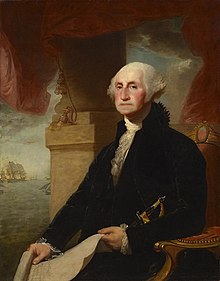User:LavaBaron/sandbox/GW
The attempted theft of George Washington's head was an attempt, in 1830, to steal the skull from the remains of George Washington. The thief accidentally decapitated Bushrod Washington, instead. The desecration of the Washington family crypt prompted a new, more secure, burial vault to be constructed.
Background[edit]

Following his death in 1799, the United States government prepared to transfer the remains of George Washington to the United States Capitol which had been built with a specially constructed crypt in its basement designed to house the patriarch's body. Despite specifications in Washington's will that he be interred at his Mount Vernon estate, Martha Washington consented to have her husband's body transferred to the capital city. Nonetheless, arguments concerning the details of the committal arrangements severely delayed the transfer of Washington's remains which were, in the interim, placed in a separate crypt on the Mount Vernon estate.[1] [2]
Over the next 30 years, the Mount Vernon crypt fell into increasing disrepair. The situation was exacerbated by a large number of "pilgrims" who traveled to Washington's grave to retrieve artifacts, generally including foliage. This resulted in trees and other flora around the tomb being stripped bare. The Russian ambassador to the United States even removed an entire branch from a tree growing next to the tomb for later presentation to Tsar Alexander I.[3]
Theft[edit]
In 1830, John Thornton Augustine Washington, then proprietor of Mount Vernon, fired one of the estate's gardeners, whose name has since been lost to history. Out of revenge, the gardener broke into the crypt with the intent of stealing the skull from the body of George Washington. The gardener accidentally removed and absconded with the head of Bushrod Washington, who was also buried in the crypt, instead. The extremely dilapidated state of the tomb reportedly contributed to the gardener's confusion; some twenty members of the Washington family had been placed in the crypt but many of their coffins had since rotted through, meaning human skeletons lay littered on the ground (the bodies of George and Martha Washington, however, had been encased in lead prior to committal and so were "spared this indignity").[4][5]

Aftermath[edit]
As a result of the attempted theft, John Washington ordered the construction of a new crypt near the existing one. The bodies of George and Martha Washington were moved to the new facility in 1831. In 1837, a new and more elaborate sarcophagus was constructed into which the original lead interior coffin was transferred. At that time, the coffin was unsealed for the first and last time so John Washington could view his uncle's body. According to a report published in Harper's New Monthly Magazine, the corpse was of "large dimensions" and "appeared to have suffered little from the effects of time".[6][5]
Theft of hair[edit]
A claim has been made that locks of hair were removed from the body of George Washington during the 1837 unsealing, though attempts to auction them in recent years have proved unsuccessful and doubts about their authenticity have been raised.[7]
References[edit]
- ^ Conradt, Stacy (22 September 2009). "10 Facts About the U.S. Capitol Building". Mental Floss. Retrieved 11 April 2016.
- ^ "The Resolution to Bury President George Washington at the U.S. Capitol". house.gov. United States House of Representatives. Retrieved 11 April 2016.
- ^ "Pilgrimages to Washington's Tomb". mountvernon.org. Mount Vernon Ladies' Association. Retrieved 11 April 2016.
- ^ Craughwell, Thomas (2009). Stealing Lincoln's Body. Harvard University Press. pp. 77–79. ISBN 0674029976.
- ^ a b Carlson, Brady (2016). Dead Presidents. W. W. Norton & Company. ISBN 9780393243949.
- ^ "The Tomb". mountvernon.org. Mount Vernon Ladies' Association. Retrieved 11 April 2016.
- ^ "October 2005 Newsletter". The American Revolution Round Table of New York. Kean University. Retrieved 11 April 2016.
